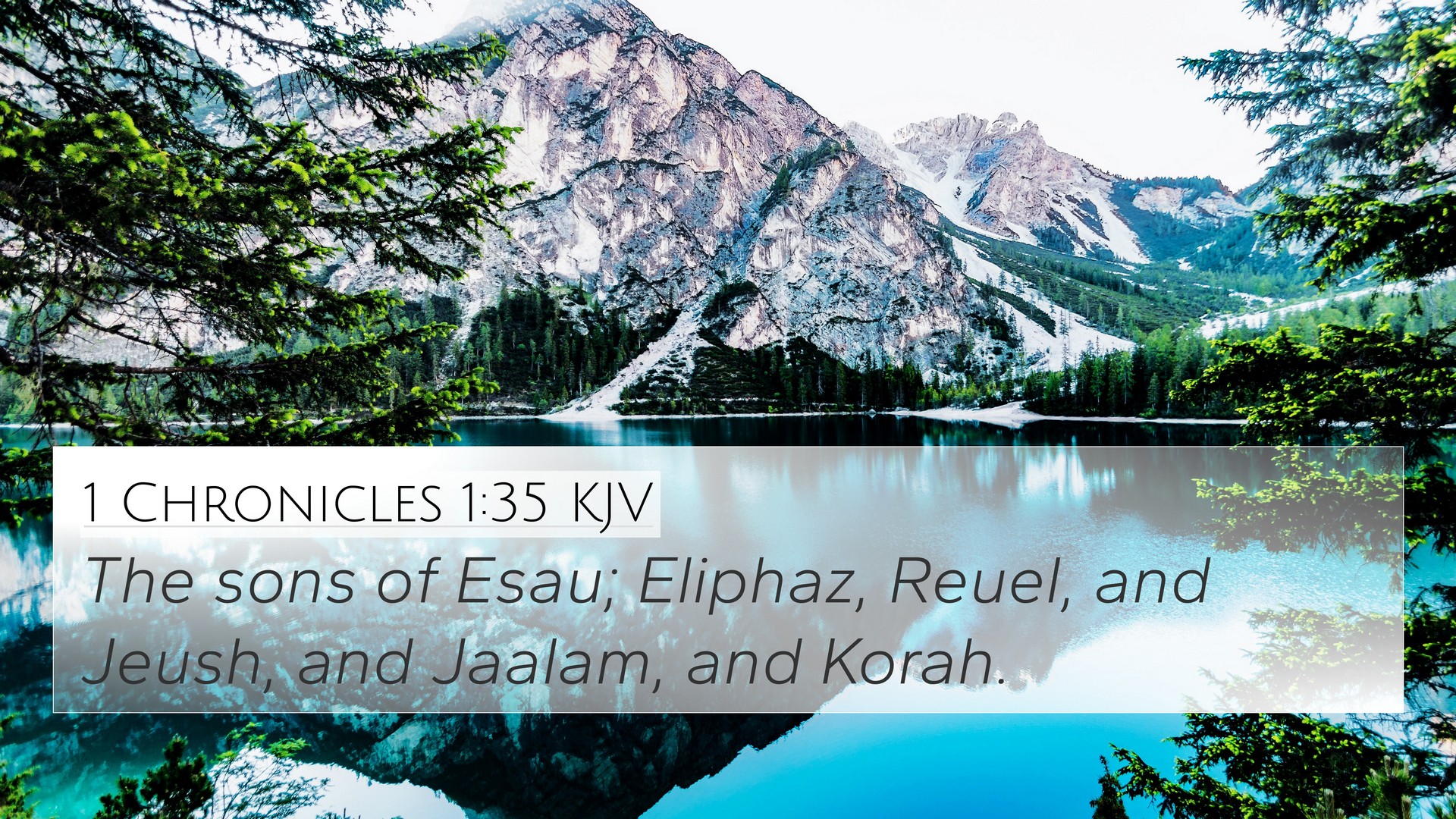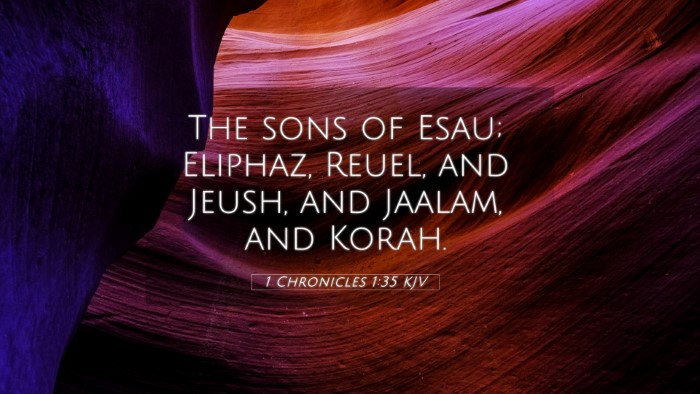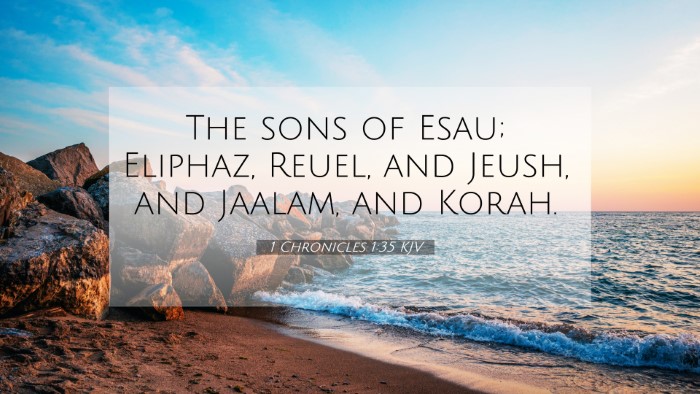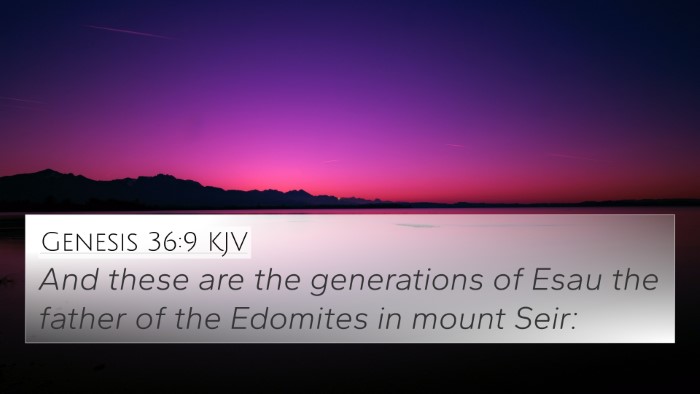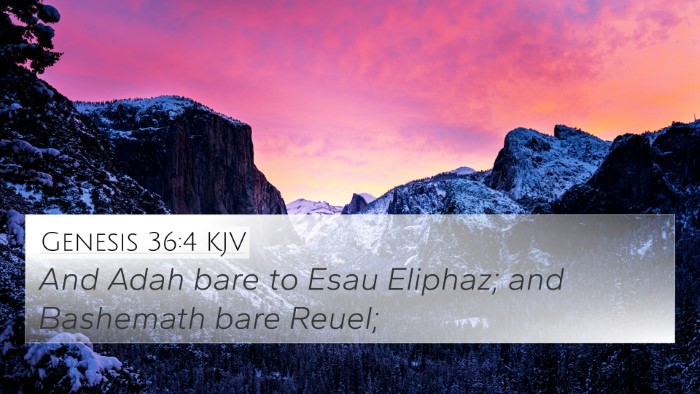Understanding 1 Chronicles 1:35
Verse: "The sons of Esau; Eliphaz, Reuel, and Jeush, Jaalam, and Korah." (1 Chronicles 1:35, KJV)
Summary and Explanation
The passage in 1 Chronicles 1:35 presents a genealogy listing, specifically focusing on the descendants of Esau. This verse is significant as it encapsulates the lineage of a key figure in biblical history, connecting the reader with deeper themes of inheritance, identity, and God’s promises. Commentators like Matthew Henry, Albert Barnes, and Adam Clarke provide valuable insights into the implications of such genealogy, emphasizing the importance of understanding the family's relationships and roles within the larger narrative of Scripture.
Insights from Commentaries
-
Matthew Henry:
Henry emphasizes the significance of genealogies in Scripture, positing that they serve to illustrate God's promises and faithfulness through generations. The listing of Esau's sons shows the fulfillment of God's word towards Esau, who was promised to become a great nation (Genesis 36:9).
-
Albert Barnes:
Barnes notes that this passage is part of a larger genealogical record aimed at affirming the heritage and descendants of Israel's adversaries. He suggests that understanding these connections reveals the broader narrative of conflict and divine purpose between Jacob (Israel) and Esau.
-
Adam Clarke:
Clarke points out the names listed in this verse represent key clans of the Edomites. He elaborates on the historical and theological implications of the Edomites’ relationship with Israel, reminding us that this was a nation with whom Israel often clashed.
Biblical Cross-References
This verse connects to several other passages that enrich our understanding of the themes presented:
- Genesis 36:9-12 - Additional details about the descendants of Esau.
- Obadiah 1:10-14 - A prophecy against Edom, the descendants of Esau.
- Malachi 1:2-3 - God’s statement on His love for Jacob and hate for Esau.
- Romans 9:13 - A New Testament reflection on God's sovereign choice regarding Jacob and Esau.
- Hebrews 12:16-17 - A warning against the characteristics of Esau.
- Genesis 25:23 - God's pronouncement about the nations that will come from Jacob and Esau.
- Genesis 36:31 - Listing the kings who reigned in the land of Edom, highlighting the establishment of Esau’s lineage.
Connections Between Bible Verses
This passage provides a clear illustration of thematic Bible verse connections between the Old and New Testaments. The genealogies and their implications often bridge teachings about human nature, spiritual legacy, and divine sovereignty.
Exploring Genealogies in the Bible
Understanding genealogies like that of Esau's descendants can enhance our personal Bible study. Utilizing tools such as a Bible concordance or cross-reference Bible study guides can assist in identifying these intricate connections. Here are some methods for cross-referencing Biblical texts:
- Utilize a Bible cross-reference system available in many study Bibles.
- Engage with comparative undertakings like comparative Bible verse analysis to see thematic relationships.
- Explore resources for Bible chain references to follow thematic threads chronologically.
How to Use Bible Cross-References
Learning to identify and utilize cross-references enhances your understanding of Scripture. Here are some suggestions:
- Begin with the highlighted verse and trace connections to related themes.
- Examine different translations and commentaries for varied interpretations.
- Consider keeping a journal of insights that arises from your studies to deepen retention.
Conclusion
In exploring 1 Chronicles 1:35, we see not just a list of names but a tapestry of heritage, conflict, and God's ongoing work in human history. The connections made through cross-referencing these scriptures deepen our understanding not only of the past but also of its relevance to our spiritual journeys today.
